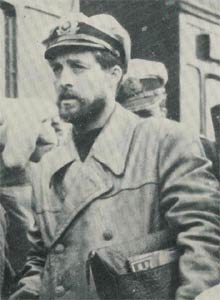German U-Boats Surrender in Northern Ireland
On 14 May 1945 HMS Hesperus, HMCS Theford Mines, and USS Paine escorted 8 German U-boats – under the command ofOberleutnant zur See Klaus Hilgendorf – sailed into Lough Foyle, en route to Londonderry. While such a sight a few months earlier would have sparked warning sirens this day was one of joy. These 8 deadly vessels were officially surrendering to Admiral Sir Max Horton, commander of the Western Approaches.
The Battle of the Atlantic
The Battle of the Atlantic, and the war against the Kriegsmarine, was the longest battle of World War II. Germany attempted – as it had in the Great War – to cut the island nation of Great Britain off from the outside world in a naval blockade. Beginning on 3 September 1939 with the sinking of the liner Athenia off the northwest coast of Ireland, the battle did not end until just hours before the final surrender. On May 7–8. U-320 was sunk by an RAF Catalina becoming the last U-boat to be sunk; while the Norwegian minesweeper NYMS 382 and the freighters Sneland I and Avondale Park were torpedoed in separate incidents, just hours before the German surrender.
The losses were heavy on both sides. In all, more than 100,000 individuals lost their lives in the Battle of the Atlantic. Some 3,500 merchant ships and 175 Allied warships were sunk with the loss of 36,200 sailors and 36,000 merchant seamen killed. 783 U-boats and 47 German surface warships were sunk. The U-boat fleet lost almost 32,000 men killed, with 5,000 captured. Their death toll was a frightening 82% of personnel.
The only thing that really frightened me during the war was the U-boat peril. I was even more anxious about this battle than I had been about the glorious air fight called the ‘Battle of Britain’.
Prime Minister Winston Churchill
Although neutral, the Irish Free State or Éire, did not avoid the Battle of the Atlantic. As an island nation it was by default caught up in the war resulting from its close proximity to Great Britain and of course – Northern Ireland.
It entered the war with a very depleted Merchant Navy and with no Navy at all. In total Ireland entered the war with 56 merchant ships on the Irish registry, none were ocean going. In order to supply the island nation, Irish Shipping was established in 1941, and 15 ocean-going dry cargo vessels were purchased or chartered. In a period known as ‘the Emergency’ or the ‘Long Watch’ by the Irish Merchant Navy, no more than 800 were serving in the Irish Merchant fleet at any time. During the period 1939 – 1945, 136 merchantmen were killed onboard 16 ships that were lost. In addition 14 fishermen were killed aboard two fishing trawlers.
No country had ever been more effectively blockaded because of the activities of belligerents and our lack of ships …
Taoiseach (Prime Minister) Éamon de Valera, Saint Patrick’s Day address 17 March 1940
The Surrender
By May 1945, the war in Europe was all but over; the Allies had defeated Nazi Germany. Following Hitler’s suicide on 30 April, Grand Admiral Karl Dönitz became Head of State and Supreme Commander of the Armed Forces. With most of Nazi Germany now occupied, Dönitz did not have much in terms of military capable of continuing the war. Only the Kriegsmarine’s U-Boat Arm was capable of continuing operations. By this time there were some 170 operational U-boats, mainly operating from occupied Norway. There were a further 200 boats under construction, in or in training based in German Baltic ports. Dönitz had hoped not to surrender the Kriegsmarine; he hoped to save their honour by scuttling the fleet. Code-named ‘Regenbogen’ only ships that would be needed for fishing, transport and mine clearance after the war should remain intact.
All of this was taking place in the midst of negotiations and the fast paced drive of Allied forces. Admiral Hans-Georg von Friedeburg had succeeded Dönitz as commander-in-chief of the Kriegsmarine. On 4 May – the day Regenbogen was due to be ordered – the German surrender at Lüneburg Heath took place.
Dönitz issued an order to all U-boats to cease combat operations and return to port or surrender to Allied naval vessels.
‘U-boat men! Undefeated and spotless you lay down your arms after a heroic battle without equal. We remember in deep respect our fallen comrades, who have sealed with their death their loyalty to the Führer and Fatherland. Comrades! Preserve your U-boat spirit, with which you have fought courageously, stubbornly and imperturbably through the years for the good of the Fatherland. Long live Germany!’
Grand Admiral Karl Dönitz message to all U-boat commanders across the globe.

At 08:45 on 10 May at Loch Eriboll on the far north Sutherland coast, the first German U-boat – a Type Vll/C41 U-1009 – entered a British base to surrender. In command of the U-boat was Oberleutnant Klaus Hilgendorf, a career Kriegsmarine officer; his war, however, was not over just yet as he was placed in command of a small flotilla of U-boats that would surrender in Northern Ireland four days later.

As U-boats began to surrender it was decided to hold an official ceremony; Lisahally on Loch Foyle, Londonderry was chosen. It was fitting for the surrender to take place in Loch Foyle and Londonderry as it had played a pinnacle role in the Battle of the Atlantic. At a peak, 139 Allied ships had their home base at Lisahally or Londonderry; while Royal Air Force and Royal Navy aircraft patrolled the Atlantic from several airfields in the area.
After mooring Oberleutnant Klaus Hilgendorf formally surrendered to Admiral Sir Max Horton – he himself a Great War submarine hunter. Horton was joined by the Prime Minister of Northern Ireland Sir Basil Brook and Colonel Dan Bryan of the Irish Free State’s Director of Military Intelligence G2. The ceremony was watched by hundreds of airmen, soldiers, sailors and locals.


